33 Keys to Decoding the Korean Wave, Hallyu
#1 The Spirit of Bibimbap
From Nam Jun Paik to BTS
*한류를 이해하는 33가지 코드 #1 비빔밥 정신 <한국어 버전, Korean version>
http://www.nyculturebeat.com/index.php?mid=Focus&document_srl=4073187
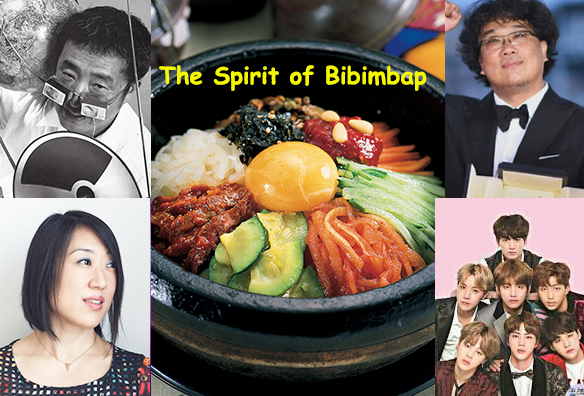
Dynamic Korea, Sparkling Koreans / Nam June Paik praised “the spirit of bibimbap.” Director Bong Joonho's “Parasite” is a film that mixes genres. K-Pop, including BTS, is a blend of Korean music with rock, hip-hop, rap, and dance music. Young Jean Lee, the first Asian-American playwright to stage on Broadway, was also recognized for her experimental ability to mix genres. Stone Pot Bibimbap Photo: MissKorea BBQ Restaurant, NYC
“As long as Korea has the spirit of bibimbap, you can have confidence in the multimedia era.”
-Nam June Paik (1932-2006), video artist, 1967
“We mix and eat together, enjoying individual flavors and harmonious tastes together. It's like the difference between a solo and a symphony in music... Bibimbap is a 'Symphony of Flavors'."
-Lee O-young (1934-2022), critic/ novelist, 2006
#1 The Spirit of Bibimbap
BTS and K-Pop, director Bong Joon-ho (Parasite), Hwang Dong-hyuk (Squid Game), Momofuku Chef David Chang, composer Unsuk Chin, violinist Jennifer Koh, classical comedy duo Igudesman & Joo, playwright Young Jean Lee, artist Ik-Joong Kang, and The Father of Video Art Nam June Paik ... What do these Koreans who have shaken the culture world have in common?
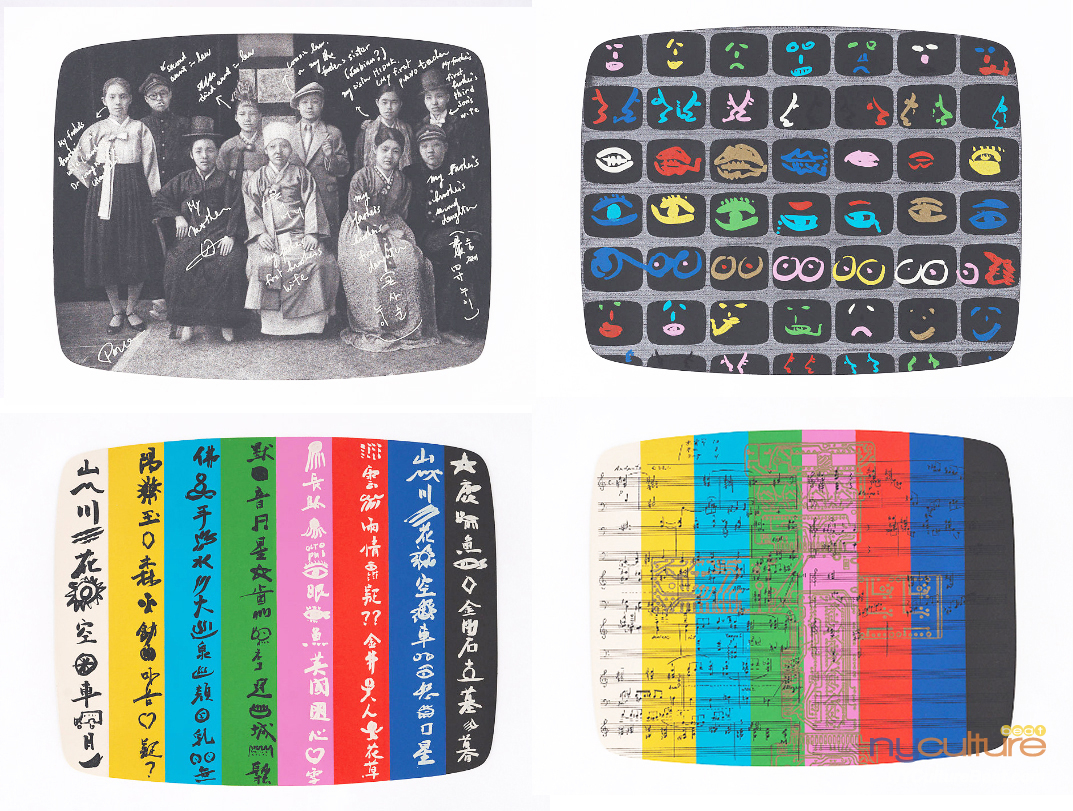
Nam June Paik, V-Idea, a priori, 1984, Etching and aquatint, 11 7/8 × 14 7/8 in. (30.2 × 37.8 cm). The Metropolitan Museum of Art Collection
Could it not be “the spirit of bibimbap” that Nam June Paik predicted earlier? A variety of colorful ingredients such as vegetables and meat are arranged neatly on top of rice, which is the Korean staple food, and a fried egg is decorated on top and mixed with red pepper paste. Take a close look at the colors and ingredients arranged in Bibimbap. In particular, Jeonju Bibimbap of North Jeolla Province, made with five colors (green, red, yellow, white, and black) and five flavors (sweet, salty, savory, spicy, and astringent) that includes bean sprout, minari, gingko nut, bellflower, spinach, bracken fern (gosari), mushroom, carrot, seaweed, beef, egg and others. By mixing the ingredients with gochujang, the magical red chili paste. Gochujang is a savory, sweet, and spicy fermented condiment which unifies all the ingredients in the bowl.
Bibimbap is aesthetically stylish food as well as savory, it harmonizes all different flavors together. Anything goes! You can mix any fresh vegetables depending on the season, or dump in any leftover banchan (side dishes) from your fridge. Everyone is welcomed in bibimbap. Bibimbap symbolizes openness and flexibility, as well as balance and harmony. Bibimbap contains a profound philosophy and is symbolic like the dialogues in “Parasite,” the film directed by Bong Joon-ho.
Nam June Paik wrote an essay titled “Electronics, Arts and Bibimbap” for Shin Dong-a Magazine in 1967. To him, video art was a mixed art that mixed and matched music, philosophy, technology, TV performance, sculpture, Korean and Western culture, and analog and digital that he studied abroad.
“The spirit of bibimbap is multimedia. Koreans know how to properly roll up complicated situations and support them well. Bibimbap is a complicated situation. Bibimbap is a participatory art. Unlike other dishes, it is unique to eat it after mixing by yourself." Nam June Paik emphasized. His wife Shigeko Kuboda, Japanese video artist, also recalled during her lifetime, “Nam June liked bibimbap very much. He used to say that his works were similar to bibimbap.”
Throw Everything Together and Add

Multiple Dialogue Infinity with Nam June Paik, 2009-2010, 62,000 Works, National Museum of Contemporary Art in Korea, Gwacheon, Korea, Photo: InSup Shin
Born in Seoul, Nam June Paik studied piano and composition as a teenager and went to Hong Kong in 1949. After the outbreak of the Korean War in 1950, he went to Japan, majored in composition and music history at the University of Tokyo, and received a master’s degree with a concentration in “Arnold Schöenberg Studies.” In 1956 he moved to West Germany to study architecture, music history and philosophy. He met avant-garde musician John Cage there and became a member of the Fluxus group, where he was also called a “cultural terrorist from Asia.” Nam June Paik relocated to New York City, further establishing himself as a figure in the countercultural and avant-garde movements of the 1960s.
In a press release for the exhibition “Nam June Paik: Art in Process” in May 2022, the Gagosian art gallery in New York said, “Nam June Paik’s extensive social network and international background laid the foundation for a global conception of art that straddled painting, sculpture, performance, music, and electronic imagery. An increasingly prescient and significant figure in today’s world of mass media and artificial intelligence, he cultivated moments of overlap, exchange, and symbiosis between the human body and its technological counterparts.” Nam June Paik was a conductor and pioneer of art who integrated his global knowledge and art genres like bibimbap.
In 1994 Nam June Paik, 62 and Ik-Joong Kang, 34 held a two-person exhibition “Multiple /Dialogue: NAM JUNE PAIK & IK-JOONG KANG” at the branch of The Whitney Museum of American Art at Champion in Stamford, Connecticut. The New York Times' critic Vivien Raynor wrote a review of the show saying that Eugenie Tsai, the exhibition curator and director of the Whitney branch (former curator of the Brooklyn Museum), pointed out that Mr. Kang likened his output and that of his mentor [Nam June Paik] to bibimbap, a Korean dish that requires the cook to “throw everything together and add.” (The phrase is also the title of an installation shown in a full-page color illustration in the show’s catalogue.)
Nam June Paik passed away in January 2006, and the duo’s second rendezvous exhibition, “Multiple Dialog ∞” was held in 2009 at the National Museum of Modern and Contemporary Art, Gwacheon, South Korea. Nam June Paik’s video tower “The More, The Better” made with 1,003 TV monitors and Kang’s “Samramansang” composed of 62,000 paintings surrounded the video tower. Vertical vs. Horizontal, Moving images vs. Still images, Life vs. Death, and Yin and Yang in harmony like bibimbap.
Kang’s mosaic installation “Throw Everything Together and Add” (1984-96), which sounds much like bibimbap, is in the collection of the Whitney Museum of American Art in NYC. In 2016, Kang exhibited “Floating Dreams”, a collection of 500 hometown drawings by the displaced people during the Korean War at the Totally Thames Festival in London. He has been creating mosaic installations composed of Hangul (Korean Alphabets), moon jars, and drawings on the theme “dreams” by children around the world.
Bong Joon-ho rejects Hollywood genres
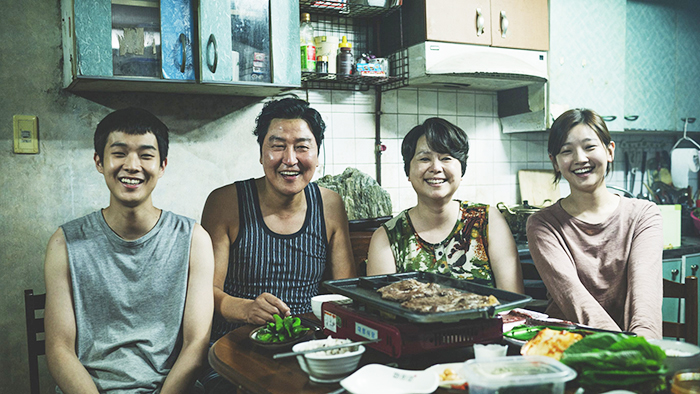
“Parasite” directed by Bong Joon-ho won the Palme d’Or at the Cannes Film Festival and the Academy Awards for Best Picture, Director, Screenplay, and International Feature Film. The film is not confined in a single genre.
Bong Joon-ho is a creative rule-breaker. He rejects conventions and skillfully combines different genres. “Parasite” did not follow Hollywood’s tradition of genre films. It is a movie that mixes and matches genres such as thriller, comedy, drama, crime, mystery and horror, and even adds social satire. And Bong Joon-ho himself became an authentic genre. Bong said at the press conference at the Cannes Film Festival in 2019, “I consider myself a genre filmmaker. I always create genre films, and a lot of my films break genre conventions, but also go back and forth between reality and genre elements. It’s almost like they’re walking on a tightrope.” The Cannes Film Festival awarded the Palme d'Or to "Parasite."

Squid Game
Netflix drama 'Squid Game' directed by Hwang Dong-hyuk, the first non-English-speaking drama to win the 2022 Emmy Award for Director, Best Actor, Best Guest Actress, Production Design, Visual Effects, and Stunt Performance for the first time. "Squid Game" also contains the spirit of bibimbap. This drama is a thriller that combines survival games with Korean neighborhood games like squid, mugunghwa has bloomed, drawing dalgona, playing marbles, and tug-of-war. Director Hwang criticized capitalism and class struggle dominated by the law of the jungle using the nostalgic games of Koreans.
105 Musical Genres Used in K-Pop
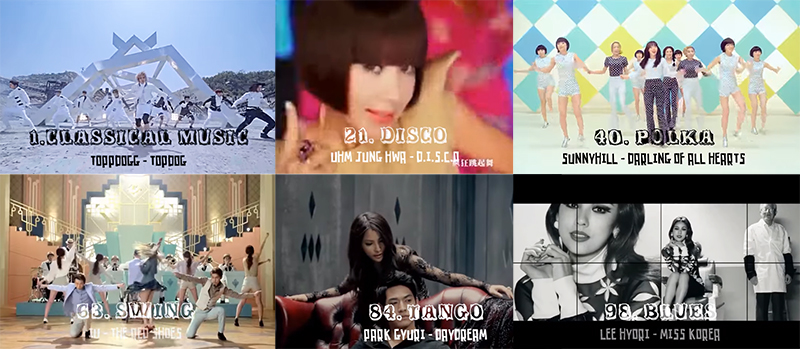
“105 Musical Genres Used in K-Pop” shows 105 music genres that appear in the songs of K-Pop singers. <YouTube>
American jazz is a genre that mixes black music, blues, ragtime, West African music and European military music. Country music was born when traditional Irish and English folk music met the blues. The global sensation K-pop (Korean popular music) is a familiar yet fresh sound of music which has its roots in Korean gayo (Korean pop music) and mixes numerous genres such as rock, hip-hop, rhythm & blues (R&B), reggae, electronic music, folk, country, classical, and gospel. And K-pop dance is also a mish-mash of different styles of hip-hop, street dance, jazz-funk and modern dance. So maybe it”s safe to say that K-pop is the bibimbap style of song and dance.
A Youtuber (hohoho hohohoho) uploaded a compilation of K-pop titled “105 Musical Genres Used in K-Pop.” The genres that were mentioned on this video are classical, hip-hop, reggae, jazz, blues, hard rock, indie, soul, new wave, disco, bebop, ballad, glam rock, swing, a cappella, baroque, gayageum, trot, punk pop, country, polka, acoustic, bossa nova, salsa, tango, Latin jazz, organ music, Egyptian music, flamenco, and so on.
The global superstar group BTS is no exception. They also blend pop, rock, rap, hip-hop, R&B, ballad, funk, and EDM (electronic dance music) in their music catalogs. YouTuber AlexNoelle identified more than 20 genres that appeared in BTS’s songs in “The Many Genres of BTS”.
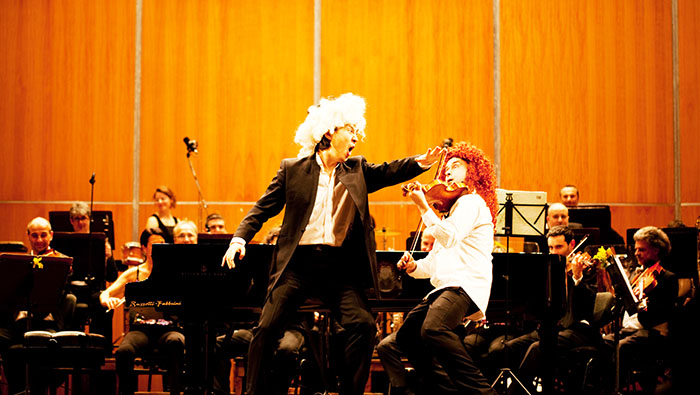
Igudesman and Joo bring comedy to classy classical music. From Big Nightmare Music http://www.igudesmanandjoo.com
Who’s not afraid of laughing at classical music performances? Enter Igudesman & Joo, “Kings of Classical-Musical Comedy.” Korean-English pianist Hyung-ki Joo and Russian-German violinist Aleksey Igudesman have gained popularity within the classical music scene, with their performance cocktail of classical music with slapstick comedy, theater, pop and music. Their absurd comic performance is so inclusive to include collaborations with actors Roger Moore, John Malkovich and singer Billy Joel. Igudesman and Joo broke the convention of classical music and pioneered a new genre. The fantastic duo performed with the New York Philharmonic on New Year’s Eve in 2013.
Hyung-ki Joo expressed his unique view of classical music performance in an interview with me for NYCultureBeat.com before the New York Philharmonic concert.
“Being Korean, but growing up in England, and then going to an international school, certainly gives you a wider cultural understanding. Imagine eating fish and chips but also having Kimchi on the table; that unusual mixture does inspire one to see things outside of convention or tradition.”
Korean-American violinist Jennifer Koh, who has performed works by contemporary composers, won the Best Classical Instrumental Solo award for "Alone Together" at the 64th Grammy Awards in 2022. "Alone Together" was digitally recorded by Jennifer Koh during the Covid-19 pandemic and features short new works donated by established composers and commissioned from talented young composers. Koh performs 39 world premiere recordings of works by established composers such as Du Yun, Vijay Iyer, Tania Léon, George Lewis, Missy Mazzoli, Ellen Reid, and Wang Lu and the emerging composers they recommended, including Katherine Balch, Nina Shekhar, Lester St. Louis, Rajna Swaminathan, Darian Donovan Thomas, and Sugar Vendil.
The New York Times described Alone Together as “a marvel for a time of crisis,” praising its lineup of composers as “more inclusive than anything in mainstream classical music.” Jennifer Koh’s ability to blend diverse elements, much like creating a Bibimbap, and turning crisis into opportunity is a distinctly Korean trait. Koh studied English Literature at Oberlin College, trained at the Oberlin Conservatory and the Curtis Institute of Music, and has received numerous accolades, including the Silver Medal at the 1994 Tchaikovsky Competition and the 1995 Avery Fisher Career Grant at Lincoln Center.
Composer Unsuk Chin, the winner of 2004 Grawemeyer Award for her Violin Concerto No. 1 and the Ernst von Siemens Music Prize in 2024, does not believe that her own music belongs to any one culture. In 2014 the New York Times described Chin as a composer who refuses to take the ethnic route. Interestingly, the title of the interview story was “Composing Outside the Lines.”
hen she talks about her influences, she lists Béla Bartók, Igor Stravinsky, Sukhi Kang and her mentor György Ligeti. Also electronic music and Gamelan, Indonesian traditional instrumental ensemble, are cited as sources of her inspiration. She often goes back to history and uses the concepts of medieval composers like Guillaume de Machaut and Johannes Ciconia. In addition, her inspiration comes from experimental poetry, pantomime, writer Samuel Beckett, and artist Olafur Eliasson.
Meanwhile, the non-verbal musical “Cookin’” (known as "Nanta" in Korean), imported from Seoul, made its New York City debut at the New Victory Theater in 2003. “Cookin’” tells the story of the chaos that ensues when a manager brings his nephew into the kitchen and instructs the chefs to prepare a wedding banquet by 6 pm. Inspired by American non-verbal performances like “Blue Man Group” and “STOMP,” creator Song Seung-hwan also incorporated elements of Samulnori (a Korean percussion ensemble of four), magic, acrobatics, comedy, pantomime, and audience participation. Since its premiere in 1997, “Cookin’” has been performed in 318 cities across 58 countries, totaling more than 46,000 performances as of August 2019, before the COVID-19 pandemic. As of 2023, the total audience for "Cookin'" has reached 14.5 million.
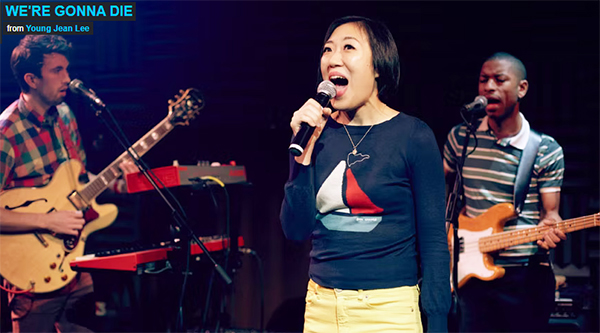
Young Jean Lee performs in "We're Gonna Die"(2011)
Hailed as “the most adventurous downtown playwright of her generation” by Charles Isherwood of The New York Times, Young Jean Lee, is a provocative and innovative playwright, director and actor. Lee became the first Asian female playwright on Broadway by staging her work, “Straight White Men” at the Helen Hayes Theater in 2018. “We’re Gonna Die”, which she originally starred in, wrote the book, lyrics, and co-composed, was revived at the Second Stage off-Broadway theater in 2020. It was a hybrid of storytelling, stand-up, music, and theater. Even the theater advertised “We're Gonna Die” as: “It’s not a musical, it’s not a play, it’s not a concert, it’s not about death.”
Lee was the recipient of the 2019 Windham Campbell Literature Prize for Drama awarded by Yale University. As the reason for the selection, Yale University said, “Young Jean Lee is a genuinely original playwright and theater-maker who explores diverse theatrical styles, forms, and subjects with a dramaturgy that constantly takes risks and pushes the boundaries of what is possible.”
Star chef David Chang, the King of Momofuku Empire, did not stick to authentic Korean food. When he opened Momofuku Noodle Bar in the East Village in 2004, among the items on the menu were Japanese ramen, Pork Bun, a pork belly sandwich inspired by Peking duck from China, and Tteokbokki, the Korean spicy rice cake. His menu was a crossover and fusion of Korea, China, and Japan. At his second Momofuku restaurant, Ssäm Bar, ssamjang, a mixture of gochujang and doenjang, is served instead of ketchup. David Chang’s goal was not to introduce Korean food to the world. In an interview with me for The Korea Daily of New York in 2010, he said that he just wants to “serve delicious American food,” regardless of nationality.
David Chang expanded his culinary empire to cities like Los Angeles, Washington D.C., Las Vegas, Miami, Wilmington, Toronto, and Sydney. Chang is a recipient of multiple James Beard Foundation Awards, including Rising Star Chef of the Year (2007), Best Chef New York City for Momofuku Ssäm Bar (2008), Best New Restaurant for Momofuku Ko (2009), Outstanding Chef (2013), and Who's Who in Food and Beverage in America (2014). He was also named one of Time magazine's "100 Most Influential People" in 2010.
Deconstructing Korean Food
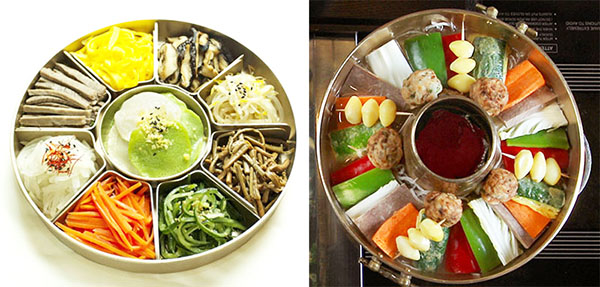
Gujeolpan (left) and Shnsello, MissKorea BBQ Restaurant, NYC
Bibimbap is not the only Korean dish that mixes ingredients. Japchae, stir-fried glass noodles with vegetables, is the staple food of a feast, and Japtang, a stew boiled with leftovers. How about the elegant royal hot pot called Sinseollo? It is cooked on the table with meatballs, jeonyueo (fish fritter), abalone, mushroom, and vegetables cooked in a beef and radish broth. The ingredients of the beautiful Shnsello are disassembled and merged into the broth.
Budae Jjigae, Army Stew, is not to be missed. The dish was born just after the Korean War, when there was a shortage of food. Koreans who worked with the US military made the stew with surplus foods from U.S. military bases, such as ham, hot dog sausage, spam, baked beans, and added kimchi, and gochujang, later instant ramen noodles. Many years have passed since Koreans came out of poverty; we still love Budae Jjigae.
Anthony Bourdain, the late chef and host of CNN’s “Parts Unknown,” was a big fan of the dish. In his cookbook “Appetites” (2016), Bourdain described the history of the dish with a recipe.
“This is known as Korean army stew, created, according to legend, from scrounged army PX canned goods during wartime. ... It’s the ultimate dorm food. Just looking at the ingredients might make it sound like a horror, but it very quickly comes together and becomes delicious. It captures the essence of great cooking over the last few centuries: improvisational, born of war and hardship, nostalgic, sentimental, and transformative.”
Ssam, wrapped dish, contains the wisdom, inclusiveness, and philosophy of Koreans. Gujeolpan, a royal ssam, consists of eight delicacies of vegetables and meat: such as carrot, cucumber, mushroom, radish, bean sprout, egg, beef, shrimp and a stack of thin pancakes. Gujeolpan is a food that not only harmonizes Osaek (five colors: blue, red, yellow, white, and black) and Omi (five flavors: sour, sweet, bitter, spicy, salty), but also balances nutrition with flora and fauna ingredients. Also, Gu (nine) is a number that symbolizes fullness.
David Chang’s hit dish of Momofuku Ssäm Bar is Bo Ssäm ($250). The pork shoulder is marinated in brown sugar and kosher salt, then baked for 6-8 hours and served with raw oysters, lettuce, rice, kimchi, Korean barbecue sauce, ginger green onion sauce, and ssamjang. Chang taught New Yorkers how to eat ssam by holding lettuce in the palm of their hand and put in pork, ssamjang and wrap and eat. Ssäm Bar was named New York Magazine’s Best New Restaurant in 2007.
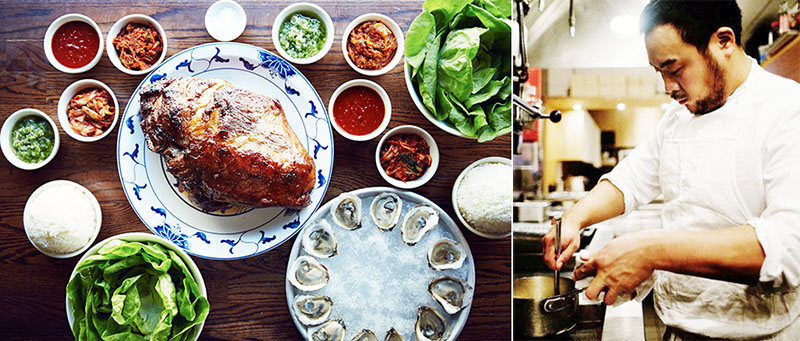
Bo Ssäm at Momofuku Ssäm Bar, Photo: William Hereford/ David Chang Photo: Gabriele Stabile
Koreans also love to mix and match food. In order to solve the problem of whether to eat Jjajangmyeon (noodles in black bean sauce) or Jjamppong (spicy seafood noodle soup) at Chinese-Korean restaurants, Jjamjjamyeon was introduced. In the movie “Parasite” by Bong Joon-ho, “Jjapaguri” translated as RamDong (ramen + udon), was prepared by mixing instant Jjapaghetti (instant noodle with black bean sauce) and Neoguri (instant udon) topped with tenderloin meat as a garnish to symbolically capture class differences in Korean society. When “Parasite” was released at Lincoln Center’s Film Society, Jjapaghetti and Neoguri were served to the audience.
Have you ever heard of a dish called Samhap? It's a golden trio of boiled pork (Soo Yook), fermented skate and kimchi. Surf and turf with kimchi on a plate maximizes taste and nutrition. Samhap is complete when served with a bowl of Makgeolli (milky rice wine).
New York, once called the “Melting Pot,” has since become more of a “Salad Bowl” that integrates different cultures while maintaining their identities. Canada, which has a large number of immigrants, is called a “Cultural Mosaic.” Now, New York should also aim for a city that converges with the spirit of Bibimbap and Ssam for harmony and balance.
“Anything Goes” Korean Culture
We Koreans have “the spirit of Bibimbap.” Bibimbap allows the arts of crossover and fusion of any genres. Unlike modernism represented by standardization and uniformity, Bibimbap has the aesthetics of postmodernism that emphasize diversity and individuality. Bibimbap is a healthy food that creates a synergistic effect by daringly dismantling the various ingredients placed on the rice, and then mixing them together as if they were performing directly with gochujang sauce. In Japan, mixing the food presented elegantly is considered taboo. However, Koreans are self-confident folks who naturally mix and rub various ingredients in the bowl in front of them. We like to perform at the table and share the diverse food together.
Bibimbap is mixed in a bowl whereas Bossam is eaten by putting vegetables on the palm of the hand and wrapping it with rice, meat, green onion, ssamjang, etc. Bojagi (wrapping cloth) can be transformed into a flexible bag that can be packed with anything, and Bottari (cloth-wrapped package) is convenient when moving from place to place. Korea has developed a habit of embracing food, clothing, and shelter, as well as movies, dramas, and K-pop. The aesthetics of openness, flexibility and harmony of “Anything Goes” seem to be the lifeblood of today’s Hallyu.
Sukie Park
A native Korean, Sukie Park studied journalism and film & theater in Seoul. She worked as a reporter with several Korean pop, cinema, photography and video magazines, as a writer at Korean radio (KBS-2FM 영화음악실) and television (MBC-TV 출발 비디오 여행) stations, and as a copywriter at a video company(대우 비디오). Since she moved to New York City, Sukie covered culture and travel for The Korea Daily of New York(뉴욕중앙일보) as a journalist. In 2012 she founded www.NYCultureBeat.com, a Korean language website about cultural events, food, wine, shopping, sightseeing, travel and people.

33 Keys to Decoding the Korean Wave, Hallyu
Beyond BTS, Parasite & Squid Game
CONTENTS
#Prologue: 국풍인가, 국뽕인가 Dynamic Korea, Sparkling Koreans
#1 비빔밥 정신 The Spirit of Bibimbap
#2 빨리빨리 문화 The Culture of Ppalli Ppalli
#3 눈치의 달인들 Homo Nunchius Korean
#4 저항의 민족 People of Resistance
#5 한(恨)과 한국영화 르네상스 Country of Trauma, Culture of Drama
#6 쇠젓가락 유전자 The Magic of Metal Chopsticks
#7 세탁의 장인들 Masters of Laundry
#8 복(福)을 싸드립니다: 보자기, 보따리와 보쌈 Bojagi, Bottari, Bossam
Joseon, Corea, Korea
#10 호머 헐버트와 세계인들의 한글예찬 Hangul, the Korean Alphabet
#11 '오징어 게임'과 '놀이의 왕국' 코리아 'Squid Game' and Homo Ludens Korean
#13 음주가무-먹고 Eat
#14 음주가무-마시고 Drink
#15 음주가무-노래하고 Sing
#16 음주가무-춤추고 Dance
The Power of Koreans
#17 미 태권도의 대부 이준구 대사범 The Father of American Tae Kwon Do, Jhoon Rhee
#20 82년생 김지영 도서 한류 열풍 K-Books and Korean Feminism
#24 '비디오 아트의 선구자' 백남준과 후예들 Nam June Paik and His Descendants
#25 K-클래식: 정경화에서 조성진까지 콩쿠르 강국 The Korean Musical Mystery
#26 비틀즈 Vs. 방탄소년단 The Beatles vs. BTS
#27 입양한인 예술가들 K-Adoptees Shine in the Art World
K-Culture Renaissance
#28 K-Food 한식 엑스타시 The Wide Spectrum of Korean Taste Buds
#29 K-Art 단색화 부활하다 The Revival of the Korean Monochrome Painting
#31 K-Beauty 성공신화 The Myth of K-Beauty
#32 K-Spa '한국 스파의 디즈니랜드' 찜질방 Jjimjilbang, The Disneyland of Korean Spa
#33 K-Quarantine 기생충, 킹덤과 코로나 팬데믹 K-Quarantine: 'Parasite' 'Kingdom' and Pandemic
#Epilogue






음악에서 독주와 교향곡의 차이가 다르듯이 맛이 확연히 구별됩니다. 비빔밥을 "맛의 교향곡"이라고 예찬한 이어령 선생님의 평에 전적으로 동의합니다.
-Elaine-